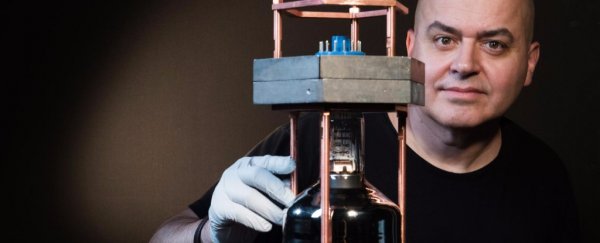Using a device not much bigger than a wine bottle, physicists have for the first time observed neutrinos physically colliding with the nucleus of an atom.
The discovery provides physicists with another way to probe this ghostly particle, one that could help us better understand some of the Universe's biggest mysteries.
Neutrinos are easy to come by down Neutrino Alley – a bunker-like corridor underneath the Spallation Neutron Source at Oak Ridge National Laboratory in Tennessee. '
Thick walls of concrete and iron filter out the rain of heavy neutrons produced at the facility, but do little to stop the small neutrinos from passing through out like ephemeral fireworks.
For the members of the COHERENT Collaboration working on the site, it was a perfect spot to find a way to detect the subtle signs of a neutrino smacking into the particles making up an atom's core.
"Neutrinos are one of the most mysterious particles," says researcher Juan Collar from the University of Chicago.
Neutrinos lack an electric charge, meaning they simply ignore the electromagnetic fields governing the behaviours of particles such as electrons and protons.
Produced in high-energy collisions and travelling near the speed of light, they can cross vast distances without being bothered much by matter standing in its way, making them well worth catching if we want to know more about the very distant reaches of our Universe.
If only catching them wasn't such a problem.
"We ignore many things about them. We know they have mass, but we don't know exactly how much," says Collar.
Mass is virtually all the particles have, and it probably isn't very much. Nobel Laureate Frederick Reines once called them "the most tiny quantity of reality ever imagined by a human being."
Nailing down their mass isn't trivial, but if it could be done it would be quite a prize.
Every neutrino exists in a weird in-between state called a superposition of three flavours, each with its own mass. There is a possible fourth flavour that's even harder still to spot, one that if found could prove to be far heavier than its cousins.
Knowing what those masses are could provide a clue on how the four fundamental forces of gravity, electromagnetism, and weak and strong nuclear force relate to one another.
Most ways of detecting neutrinos lean on some clever detective work.
For example, neutrinos can be captured by atoms, which then decay into another element. This radiochemical method is handy for detecting low energy neutrinos, but takes several weeks so can't reveal much about time or the direction of neutrino emissions.
Other methods have their own pros and cons, some able to track direction but reveal little about the nature of the particle, others requiring large facilities and complex technology.
Until now, researchers haven't had a way of spotting something called coherent neutrino scattering.
The interaction was first predicted just under half a century ago, but due to the neutrino's shy nature it's been difficult to demonstrate experimentally.
In 1974, a Fermilab physicist named Daniel Freedman predicted neutrinos could physically smack into an atom's nucleus and make it recoil.
He had little hope that we'd ever measure this wobble, claiming, "Our suggestion may be an act of hubris, because the inevitable constraints of interaction rate, resolution, and background pose grave experimental difficulties."
Some of those experimental difficulties have now been overcome thanks to the right mix of neutrino source and the right choice of material to act as a detector.
"You could use a more sophisticated type of neutrino detector, but not the right kind of neutrino source, and you wouldn't see this process," Collar said.
The neutrinos came from the nearby Spallation Neutron Source. As for the detector, the research team developed a crystal of caesium iodide doped with sodium.
Getting this detector right was crucial. For one thing, having a smaller nucleus would make it easier to pick up the recoil from the collision. But it also makes for a smaller target.
"Imagine your neutrinos are ping-pong balls striking a bowling ball. They are going to impart only a tiny extra momentum to this bowling ball," Collar said.
A significant advantage to their method is its relative simplicity – there is no need for tanks or cooling banks or panels of wiring. The detector weighs a mere 14.5 kilograms (32 pounds) and is roughly same size and shape of a rather large (and pretty heavy) wine bottle.
Having such a tiny detector makes it far more convenient to place around other sources such as nuclear power plants.
Future experiments using this new method could provide new insights into how neutrinos interact with other sub-atomic particles, such as the quarks making up a nucleus's protons and neutrons.
They could also shed some light on the dark matter making up 85 percent of the Universe's material.
Neutrinos are certainly dark as far as electromagnetic interactions go, so detecting them could provide better ways of finding solid candidates that fit the dark matter profile.
If we're to pull apart the Universe's most tiny, ghost-like qualities, we're certainly going to need more amazing tools like this one.
This research was published in Science.
